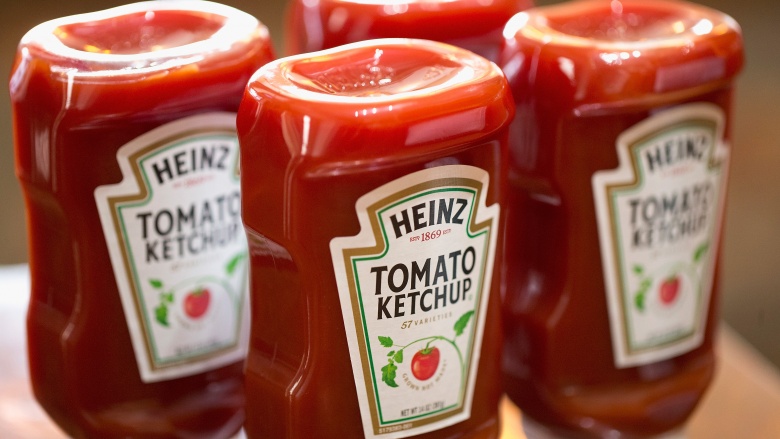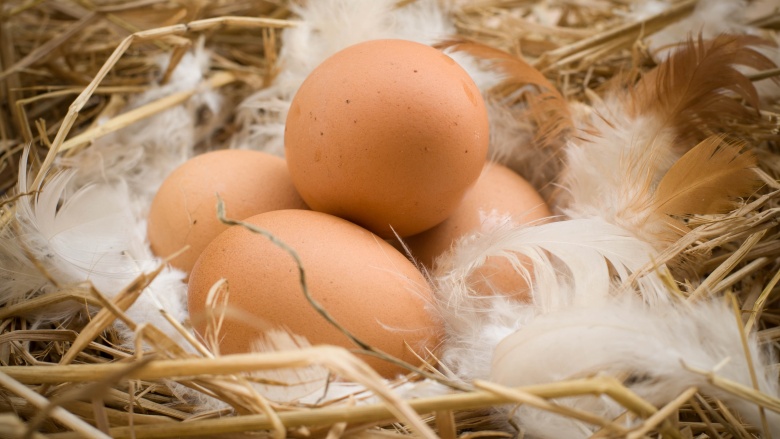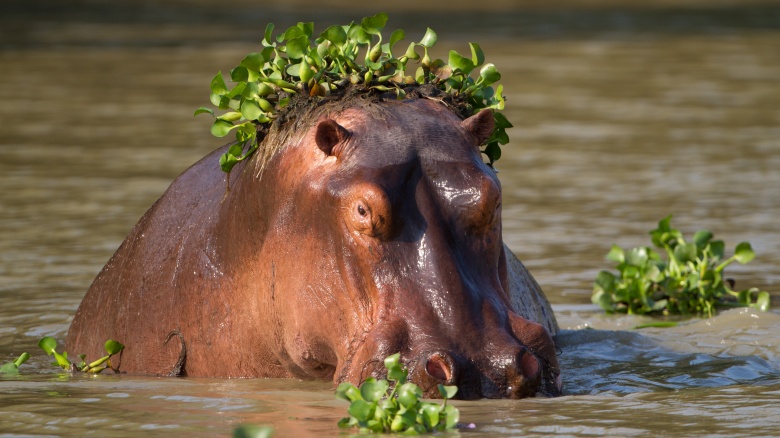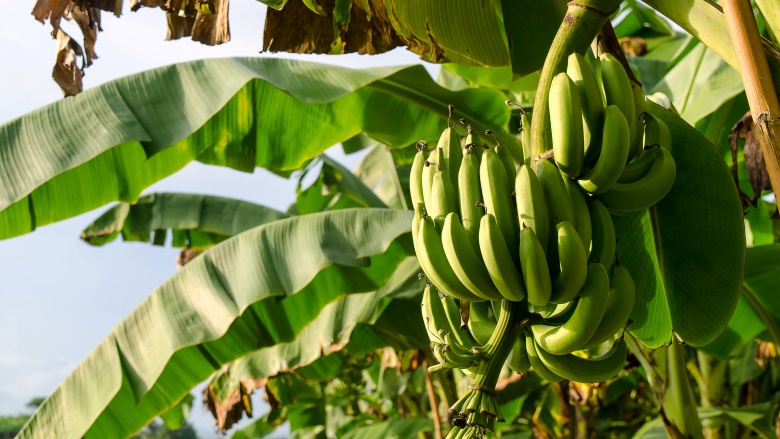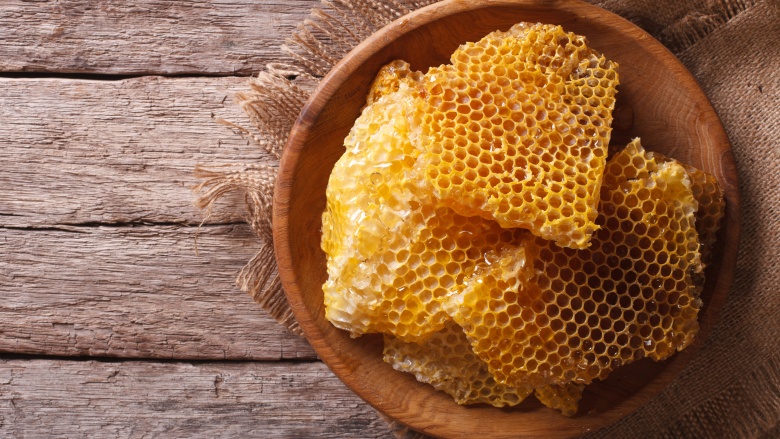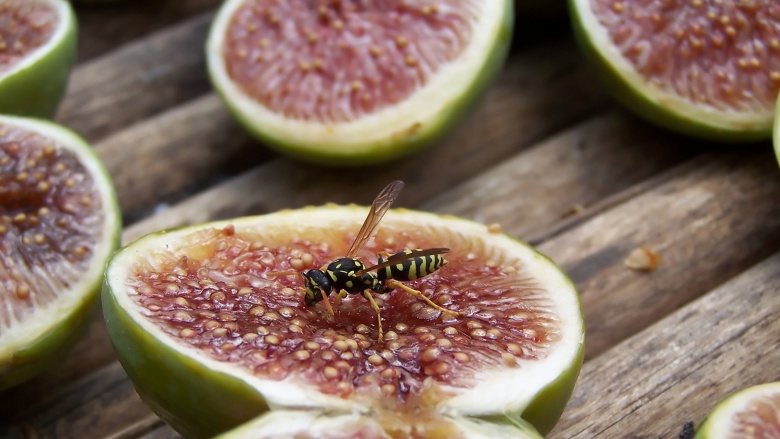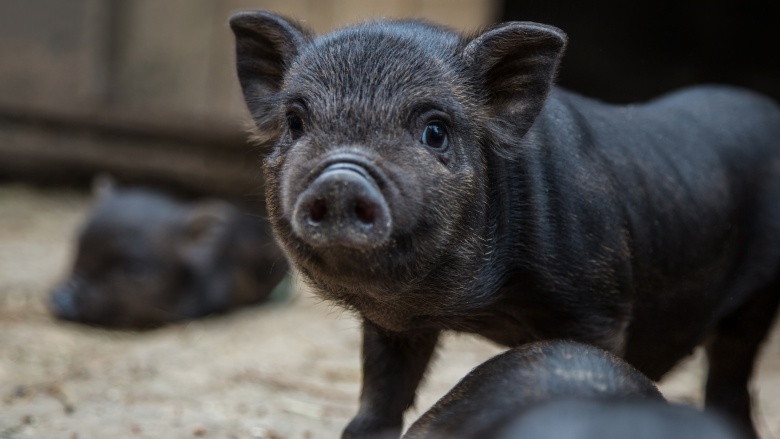Bizarre Food Facts That Are Hard To Believe
Do you have some ketchup in your fridge right now? Maybe you have some bananas on the counter, or the fixings for a wine and cheese platter just waiting for a Friday night movie. Have you made any tea lately? Eaten any dried figs? Used honey?
What do these things all have in common? Look into their history, their life cycle, and their present-day processing, and you might find some truly bizarre facts that seem next to impossible. But they're all possible, and they're all true.
Sardinia has a maggot-filled (and illegal) cheese
When it comes to pairings, there's nothing better than wine and cheese, right? You might want to give this illicit cheese from Sardinia a miss, though, as this local delicacy is only considered ripe when the maggots reach the right amount of wiggle. According to some, if they aren't wiggling, they're dead. If they're dead, the cheese is too decayed to support them and, sadly(?), no good to eat. You probably didn't come here to hear about maggots, but c'est la vie.
The cheese is called casu marzu, and it's a local delicacy that, thanks to its newfound illegality, is now next to impossible to find unless you're in the know. It starts off as pecorino sardo. Then, cheesemakers either move hatched maggots into holes bored into the cheese, or they leave the cheese to attract the cheese flies on its own. Either way, they get there. As the maggots eat their way through the cheese, they poop digested cheese back out, and that's what you're eating. Along with, of course, the maggots themselves, as the cheese is served still-wiggling. If you're thinking this sounds like an unsanitary nightmare of a health risk, you're in agreement with the EU. They banned the cheese for understandable reasons, including the fact that if you don't chew really, really well, the maggots can survive most of your digestive system and set up residence in your intestines. No one wants that, especially for a cheese that tastes mostly like gorgonzola.
Ketchup was once medicinal, made with shark innards and without tomatoes
Have you ever wondered why a bottle of ketchup always specifies that it's "tomato ketchup"? There's a good reason for that, and it has to do with the incredibly bizarre history of this now common condiment. The first European mention of a condiment called ke-tchup dates back to the 16th century when British sailors discovered the Chinese favorite and introduced it to the Western world. Then there were a whole bunch of different regional recipes and varieties, but the earliest recipe (from the year 534) calls for "the intestine, stomach and bladder of the yellow fish, shark and mullet" to be washed, bottled, and left to sit for up to 100 days, depending on the season. Imagine that on your hot dogs.
When the British adapted the recipe, they made their ke-tchup out of anchovies. It was made in a process that should sound at least a bit familiar, as it was essentially what we call fish sauce today. At the time they were tweaking their ke-tchup recipes, they were also terrified of today's most common ingredient, the tomato. It was a member of the nightshade family, and it was widely believed to be poisonous.
Some thought otherwise, and in 1820 a New Jersey man ate a basket of them to prove that he wasn't going to die. Only 14 years later, a doctor from Ohio declared they were a quick fix for pretty much any kind of gastrointestinal issues, and that's when they were first included in ketchup. Tomato ketchup was an extra-healthy ketchup, and it was sold as a medicinal tonic instead of a condiment. By the turn of the century, though, processing and preservation were so bad that tomato ketchup was almost always rancid by the time the consumer got it, and it was even deadly in extreme cases. It had been prepared in copper tubs, and the reaction helped make about 90 percent of tomato ketchups completely toxic. Then Henry J. Heinz entered the scene and cleaned up ketchup's act, establishing one of the most generous companies employees had ever worked for.
Only a few countries keep their eggs cold
Go to the grocery store any place outside the U.S., Japan, Scandinavia, and Australia and you won't find eggs in any refrigerated form. Visit someone's home and you'll probably find eggs sitting out on the counter. You're probably already furrowing your brow in confusion. That can't possibly be good ... can it?
It all has to do with what happens to the eggs once they're taken away from the chickens. In these countries, eggs are subjected to a washing process that cleans the eggs with hot, soapy water and washes off a naturally occurring protective layer on the outside of the shells. Eggs aren't porous when that coating is intact, so water and bacteria stay out. For whatever reason, Americans became terrified of dirty chickens and dirty eggs and the spread of salmonella, so the government insisted on this egg-washing process in the 1970s. In theory, it helps keep the eggs safe, but most European countries fight salmonella a different way: they vaccinate their chickens. That makes washing unnecessary, as the egg protects itself against any potential nastiness that might leak through the shell.
Refrigeration has one other benefit, too. It helps keep eggs fresher longer, and while non-refrigerated eggs typically last only around 21 days, cold eggs can be used up to around 50 days. Shipping cold eggs costs more, and one can argue that fresh eggs are better, anyway.
The 'other white meat' was almost hippo
You've seen the commercials for "the other white meat," right? It's pork, but there was a time when it just as easily could have become hippopotamus.
In the first decade of the 20th century, the U.S. was facing something of a food shortage. Congress was tasked with tossing around some ideas on how to feed the country's people, and one of those ideas involved importing hippos to areas like the bayous of Louisiana. (They were also going to give them a bit of an image makeover, and newspapers insisted on calling them "lake cows".) The idea was actually pretty brilliant (as long as you've never met an actual hippo), and it was meant to make use of marshes and swamps that were considered to be wasted land.
Behind the plan were some insane players, and it's a wonder that no one has made a movie out of this. Presenting the plan was Louisiana Congressman Robert Broussard, and the experts he called in were Frederick Russell Burnham (model for the Boy Scouts and an inspiration for Indiana Jones), and Fritz Duquesne (a known con man and spy). The two actually knew each other, as they had both participated in the Boer Wars and they had been assigned the task of killing each other. They never met during the war, and it was only after they were both recruited to bring hippos to the Americas that they did finally meet.
It's a crazy story, but in the end, the U.S. didn't decide to go with hippo as a solution to the problem of a food supply. It seems the main downfall of the idea was being caught in the development hell that is the federal government. Over the years, the bill to introduce hippos was pushed aside again and again, and it was eventually decided that it was a better idea to turn swampland into land usable not by lake cows, but by boring old land cows. Bummer.
Tonic water glows in the dark
Tonic water glows in the dark! If you're in a state of disbelief right now, that's the correct reaction. But it's true. Scientific American took a look at the science behind it, and it works because tonic water contains a chemical called quinine. Quinine is known to history buffs as a longstanding malaria medicine. There's only a tiny bit of it in tonic water, but it's enough to make it glow if you shine an ultraviolet light on it. Basically, the quinine absorbs the light energy, which excites the molecules that emit their own energy before being rendered inert again unless they receive more light energy.
This little tidbit of knowledge can easily be used to take your late-night parties to the next level. Delish has a whole bunch of fun ideas for using tonic water's glow-in-the-dark properties. You'll never look at a gin and tonic the same way again.
Bananas are genetic clones (and they're dying)
Genetic diversity is the key to the continuation of any species, but there's one food that, in a few generations, we might never taste again. Some experts think that the common banana we eat today could only have 20 years left at most, and that's because they're all infertile, inbred clones.
Bananas were first domesticated around 7,000 years ago, and while the details are understandably obscured by the ages, it seems that humans hybridized the banana to grow in various areas as populations spread. The bananas we eat today are pretty much all Cavendishes, and the only way we can reproduce them is by transplanting tree cuttings. It's unclear how long we can keep this up, as the identical genetic makeup of the banana means that a single disease can wipe out the entire species. It's already happened once in recent memory, with the Gros Michel. That was the common banana until the 1960s, when a banana plague called fusarium wilt spread through thousands of acres of banana plantations and wiped them out. Cavendish bananas were resistant to the fungal strain, but there are other diseases they aren't resistant to, like black sigatoka. That fungus is already here, and while banana farmers are now trying to manage it, the end is nigh for our favorite fruit that you need to unzip to get the inside bits. Fortunately, there are lots of other banana varieties out there that we can eventually replace them with.
Honey was once used in mummification
Honey is a fascinating food that lasts forever, and it's equally great for preserving fresh fruit and keeping on hand in case of the zombie apocalypse. That's not all it was used to preserve, either, and archaeologists have found that it was once an essential ingredient in mummification.
In 2012, archaeologists excavating a Bronze Age site in what's now the country of Georgia discovered some funeral offerings that were shockingly well-preserved. They were so well-preserved, in fact, that the 4,300-year-old berries still smelled like they were fresh. They, along with other offerings like chestnuts and hazelnuts, had been preserved for thousands of years by a generous coating of honey. The idea was that these honey-coated snacks would be there for the dead in the afterlife, and according to findings and support from ancient texts, we know that honey was a key ingredient in embalming the deceased, too. Even Alexander the Great was preserved (and displayed) in honey.
And this is where things get a little creepy. A 16th-century text by the Chinese apothecary Li Shizhen told of mellification, a process undertaken by holy men who, nearing the end of their life, ate only honey until it was literally leaking out of every orifice. Once they died, they were essentially preserved in honey from the inside out. The crystallized bodies were then stored in honey-filled jars until they turned to a sort of candy that was then used to treat broken bones. The truth of this account is unclear, but someone had to think of it and that's bad enough.
Tea bags were an accident
Tea aficionados might think that using a tea bag is a bit sacrilegious, but it's a heck of a lot easier than mucking about with loose tea. That convenience has made it popular, but the origins of the tea bag were accidental.
While tea dates back to somewhere around 2700 BC, the idea for the tea bag was first patented in 1901. Mary Molaren and Roberta Lawson of Milwaukee were looking for a way to brew smaller quantities of tea without wasting the leaves that were needed in brewing a whole pot. They created the Tea-Leaf Holder, which was essentially a cotton mesh bag that worked in the same way tea bags do today. The patent was granted in 1903, and immediately ... nothing really happened.
The invention completely failed to take off. Enter Thomas Sullivan, a tea merchant who was peddling his wares in 1908. When he sent out samples of his tea, he sent them in little silk bags. People were using the bags to brew a single serving of tea, placing orders, and then getting angry when those orders didn't come in little bags. He tweaked the original design a bit and found that gauze bags worked much better. That's the story, at least, and it seems like it's mostly true. Real popularity for tea bags didn't happen until the 1950s, though, when kitchen duties were all about efficiency.
An 11-year-old invented the popsicle, but his children named it
Ever wonder why it's called a "popsicle"? It's short for Pop's Sicle, which is weird when you consider that the "Pop" in question actually invented the frosty treat when he was 11 years old.
His name was Frank Epperson, and he lived in the San Francisco area when he accidentally discovered that mixing a sugary soda powder in water and freezing it created little sticks of awesome. He called them Epsicles, after his own name with "icicle." That was in 1905, and by the early 1920s, he was selling them all over the area and especially at Neptune Beach. He eventually applied for a patent, but it wasn't until his kids came along that they created the term "popsicle."
At least, that's the story as it's been passed down through the years. Unfortunately, it doesn't have a happy ending. Epperson went broke and sold the rights to his popsicle. He later said that he was never the same after letting his invention go, and he died in 1983.
Figs aren't vegan or vegetarian
This one sounds like an urban legend. Figs aren't strictly vegetarian or vegan because each one contains at least one dead wasp. Nasty! And, unfortunately for fig lovers, completely true.
Here's how it works. Figs are technically inside-out flowers, and rather than having their pollen on the outside, it's in the center of the fruit. Totally impractical, right? Since they need to attract some kind of pollinator, they do it by splitting the duties. Male figs contain structures that make the perfect receptacle for wasp eggs, so for around 34 million years, female wasps have been crawling inside figs to lay their eggs. The eggs hatch and the males, who have teeth, chew their way through the fig to allow the winged females to escape (after the newly hatched wasps mate). The males die inside the fig, and the females go on to find more figs to lay their eggs.
Female wasps don't know the difference between male and female figs, even though it's only the males that have a place for her to lay her eggs. Female wasps who find themselves in female figs successfully pollinate them, but as they rip their own wings off crawling inside, they die without depositing their eggs. Their bodies are absorbed by the fig. Enjoy your Fig Newton.
Medieval pigs kept for food sometimes ate people, instead
Pigs have been a major food source in Europe for ages, and their meat still makes up a large part of the world's diet. The medieval period seemed to go through a weird phase, though, and we have a creepy number of stories about pigs eating people and being put on trial for their crimes.
Pigs were easy to keep because they could live on pretty much anything. Medieval pigs looked a bit more like wild boars than the adorable pink pigs we have today, and they were sort of a double-edged sword. They would clean up garbage from the streets, sure, but they would sometimes be busted eating the occasional street urchin, too. It was such a problem that some cities and towns did their best to ban the keeping of pigs outright. Records are sketchy, but historians have found some accounts that'll have you scratching your head. For example, in 1295, Richard de Cantolup was accused of letting his pigs eat his son and then not turning those pigs in to the proper authorities.
And custom dictated that he should have. Pigs that ate people went on trial for their crimes and were usually executed. In 1379, three pigs were executed for eating a man named Perrinot Muet. (The entire herd was almost executed, but a monk successfully pleaded for forgiveness for those pigs that just watched and didn't actually partake in the French feast.) A 1906 book called The Criminal Prosecution and Capital Punishment of Animals documented a whole bunch of instances where pigs were found guilty of eating people in part or in whole, including one instance of a pig eating a child "although it was Friday."

